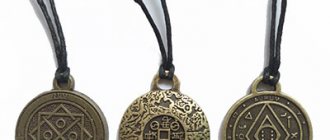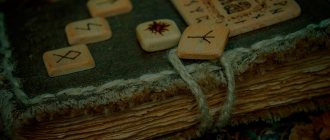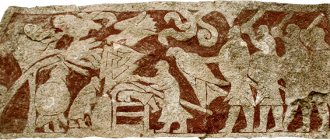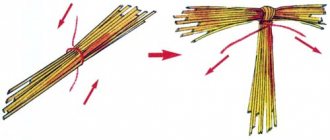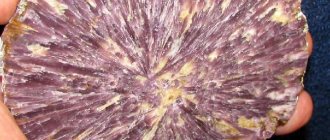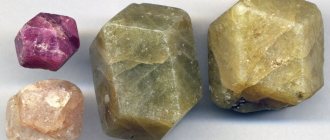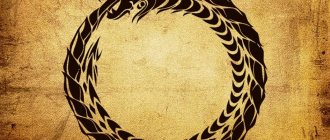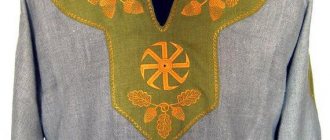The culture of Ancient Egypt from century to century excites the minds of lovers of secrets and riddles. But, despite the huge number of archaeological finds, scientists still continue to make amazing discoveries and build incredible hypotheses about the life of the most ancient civilization.
Egyptian amulets are of particular interest. Many people want to wear them as jewelry or get tattoos with ancient signs. But, before doing this, it is worth understanding the Egyptian symbols and their meaning. Now we will do this.
Beliefs of Ancient Egypt: the role of symbols and talismans
Each nation had its own amulets and amulets. Most often, the making of amulets was carried out by knowledgeable people - sorcerers, magicians, priests. According to tradition, talismans were treated with respect and love, they were hidden from prying eyes and passed on by inheritance.
Magic symbols for the ancient Egyptians had a sacred meaning.
Ancient Egypt, like other cultures, had their own amulets. Some of them were used in everyday life, others were worn as decorations and were never taken off, and others were given out on special occasions.
The most famous Egyptian symbols: the ankh cross, the eye of Horus, the scarab beetle, the cat. Almost everyone knows about them. Less recognizable are the Isis knot, the feather of Maat, Tiet, Sesen. However, in Egyptian culture they were also considered one of the leading signs.
It is worth noting that for the Egyptians, magical symbols acquired even more sacred meaning than for other peoples. This is due to the widespread cult of the afterlife in Ancient Egypt. The Egyptians treated the dead as if they were equal to the living.
They sent them on their eternal journey, decorating them with special amulets. Some of them were worn during life, and then went to the afterlife with the owner to continue to protect him in the next world.
Possible consequences
The results of wearing the Egyptian sign are hard to miss. Sometimes they can scare a person, but magicians urge not to be afraid of such phenomena, since they help to better understand the world around us and our place in it.
The most common consequences:
- The owner of the amulet begins to predict events that occur a few days later, reads the thoughts of the people around him, and feels their true attitude towards him.
- A person begins to have strange dreams in which he sees himself in other people's bodies and other eras, hears foreign languages and understands them. Esotericists claim that such dreams tell the sleeper about his past reincarnations.
- The owner of the amulet ceases to be afraid of things that previously caused him fear.
- Dramatic changes occur in a person’s destiny that he could not have dreamed of before. Moreover, all changes occur without his participation.
Character classification
Egyptian signs are found on many objects found by archaeologists. Among them are not only amulets, but also household and ritual items.
It is very easy to get confused in all this diversity, so now we will try to figure out what signs can be used to systematize Egyptian amulets.
By appearance
Sacred Egyptian symbols were applied to a variety of objects. The most ancient hieroglyphs covered not only personal items, but also temples, residential buildings, as well as tombs and sarcophagi placed in them.
What did Egyptian craftsmen make:
- figurines of Egyptian gods or figurines of animals;
- pendants in the form of sacred animals (a scarab was often found among them);
- jewelry with sacred symbols (rings, bracelets, necklaces).
A talisman in the form of an Egyptian cat will attract good luck and protect against witchcraft.
Egyptian symbols were applied not only to clothing, but also to household items. Like the Slavs, the ancient Egyptians tried to protect themselves as much as possible from troubles by depicting protective symbols on almost all their things.
By color and material
The basis for talismans was selected based on the purpose of the object or the need to assign some magical properties to it.
Some amulets were made from only one material, the most suitable, in the opinion of the priests.
What were amulets made of in Egypt?
- made of wood;
- from stones (jade, turquoise, jasper, carnelian were often found);
- made of metal (usually gold, silver or bronze);
- from wax.
Whatever Egyptian talisman you choose for yourself, do not forget to cleanse and activate it.
The colors were given no less attention than the material. They were chosen for a reason, but based on the meaning assigned to a particular shade.
According to the presence of spells
Among other things, Egyptian amulets were classified according to the presence of magic words, the so-called “words of power.” Casting special spells over amulets was a common tradition.
But only priests were allowed to do this. People without magical abilities also used words of power, but in a different way. They did not read magic words out loud, but simply put them on amulets.
What to bring from Egypt as a gift
Egyptian sweets, tea, fruits, spices will pleasantly surprise and delight your loved ones:
- Tea – date, hibiscus, lemongrass, guava. This gift will be not only pleasant, but also useful. Egypt has high-quality and delicious tea. Hibiscus is especially popular in this hot country; a sour drink with a rich red color strengthens the immune system and increases vitality. You can buy teas at any large tea store. You should not buy teas during excursions - you can pay twice as much for the same product here.
- Sweets – Turkish delight, halva, kunafa, coconut rolls, glazed dates, desserts with nuts and seeds. Egypt has a large selection of sweets that are distinguished by the unique taste of the East. Stores and markets sell interestingly packaged sets that are sure to please those with a sweet tooth.
- Spices and herbs - only in the East do they sell the most aromatic cardamom, saffron, rosemary, etc. They also offer beautiful jars for storing spices.
- Coffee occupies a special place among edible souvenirs - in Egypt they prepare aromatic coffee beans with cardamom, which coffee lovers will appreciate. You will also be pleasantly surprised by the prices for coffee.
- Fruits – fruits brought in winter will definitely please your loved ones. Egypt has a large selection of exotic fruits - melons, mangoes, strawberries, figs, pomegranates, guava, etc. You can read more in our article Fruits of Egypt.
- Carpets. Handmade carpets are popular as souvenirs. Egyptian carpets are of excellent quality and original national patterns. In addition, they are not as expensive as Iranian or Turkish ones.
- Loofah washcloths. A soft loofah washcloth is a product that nature itself created. Thanks to many beneficial properties and the content of active components, it is used not only at home, but also in cosmetology. Loofah gives an excellent massage effect, deep cleansing of pores, peeling and maintains skin tone.
Main types and meaning of Egyptian talismans
The heritage of Ancient Egypt consists not only of a huge number of amazing architectural structures, mummies and legends, but also of special Egyptian symbols and signs.
Some were used to symbolize something, while others were used as talismans. Now we will look at the most famous of them.
Ankh Cross
The Egyptian Ankh cross goes by many names. Coptic cross, key of life, knot of life, cross with a loop, key of the Nile, crux ansata - whatever they call it. Just by the name you can imagine what this symbol looks like, even if you have not seen it with your own eyes.
Outwardly, the ankh really resembles a cross - the lower vertical beam is longer than the two horizontal ones, and in place of the upper beam there is a loop. The Egyptian cross, whose overall meaning boils down to immortality, was often depicted on tombs. It was believed that it illuminated the path to the afterlife for the deceased. On amulets, the symbol meant something completely different - eternal life. It was worn to prolong existence on earth.
Eye of Horus
The Eye of Horus is one of the most famous Egyptian symbols in the world, not inferior in popularity to the cat symbol and the scarab beetle. In historical sources it is mentioned under different names, including Wadjet and the eye of Ra. The Egyptians revered Horus as the god of the sky and the sun, depicting him in the guise of a man with the head of a falcon.
There is a legend telling about the origin of the amulet. According to her, Horus lost his left eye in a battle with another deity. Set, the lord of rage, sandstorms and war, wrested it from Horus during the battle. Subsequently, the organ was restored, which led to the appearance of such a talisman.
People began to believe that the Eye of Horus had the ability to heal. In addition, it was believed that this Egyptian symbol endows its owner with insight, helps to comprehend secret knowledge and protects against dark magic.
Scarab beetle
It may seem surprising to the uninitiated that the Egyptians chose the dung beetle as their mascot. However, in such a simple action as rolling balls of excrement, the Egyptian people saw a sacred rite.
This beetle makes perfectly round balls of dung and rolls them all day long in the sun wherever it wants. The process of rolling the ball reminded the Egyptians of the sun across the sky, and the scarab became for them a prototype of one of the forms of the sun god - his morning hypostasis, Khepri.
In this regard, the scarab was turned into a symbol of rebirth, a new beginning and bright changes. An amulet with the scarab symbol was worn in difficult times to give strength and help overcome difficulties.
Isis
The wife of Osiris and the mother of Horus, Isis was one of the most significant Egyptian goddesses. She was depicted as a woman with outstretched wings, whose head was crowned with a circle of the sun or cow horns. She patronized everyone who needed protection - poor artisans, slaves, children and even the dead.
In the understanding of the Egyptians, Isis was the ideal mother, as well as the owner of feminine beauty. Her figurines were placed in the house to improve the atmosphere of mutual understanding and happiness. In addition, the figurine was used as a talisman for pregnant women.
Another Egyptian symbol is associated with this goddess - the Isis knot talisman. It is very similar to the Ankh cross, so it is easy to confuse them.
Cat
The Egyptians believed that the goddess of female beauty and hearth, Bastet, had an earthly incarnation. It is not difficult to guess what animal Bastet turned into, because she was always depicted with the head of a cat. The goddess was responsible for home comfort, harvest, cleanliness and order in the house, as well as its protection.
The flourishing of the Bastet cult was largely facilitated by the dexterity and grace of cats. They were excellent hunters, which people decided to take advantage of by domesticating them to catch mice. In addition, there was a belief that cats know how to drive out evil spirits and are able to cleanse the energy of space with their presence.
These days, the Egyptian cat tattoo has gained particular popularity. The owner of such a pattern on the body will be protected from failure and witchcraft.
Shenu
Shenu is different from other Egyptian amulets. This is not a general amulet that can protect the entire family, but an individual Egyptian symbol of protection. It looks like an oval in which they hid something that needs to be protected from negative influences.
Most often, someone’s name was put on the shenu - one’s own or a loved one’s, sometimes some symbol, a sacred inscription. It was believed that evil would not be able to penetrate this fence, which means it would not cause harm. The Egyptians wore the shenu symbol as decoration, making it into a pendant, necklace or bracelet.
Sun with wings
The winged sun is considered one of the most effective Egyptian symbols to help protect against evil. According to legend, the god Horus once took this form as he fought Egypt’s descent into chaos.
The symbol was often found above the entrance to the tomb of the pharaohs. In this case, it acquired a new meaning - it protected the deceased, and also symbolized Egypt itself.
Sesen
Sesen is a symbolic image of a flower. This flower is a lotus. For the Egyptians it means rebirth. The symbol got its meaning for a reason. The fact is that a real lotus hides at nightfall, closes its petals and completely submerges under water. And every morning he seems to be reborn, appearing renewed before the world.
A talisman with such an Egyptian symbol will be useful to anyone who feels the need to complete the current stage of life and start a new one, better than the previous one. Sesen in the form of a pendant or brooch is recommended to be worn by creative people experiencing a crisis, as well as by those who cannot get out of depression.
Feather Maat
The ancient Egyptian goddess Maat, daughter of Ra, was revered as a deity of justice. Maat, personifying law and order, helped restore the truth and bring light to the earth.
Like goddesses of justice from other cultures, Maat was depicted blindfolded. This emphasized her impartiality as a judge.
The Egyptians believed that after death every person was judged. To determine the further fate of the deceased, his soul was weighed on special scales. On the other side of the scale was the feather of Maat, which she wore on her head. If the weight of both weights turned out to be the same, the deceased found eternal peace, because he lived his life with dignity.
Heron
Many have heard about the phoenix, but few people know that the Egyptian heron served as the prototype for this fabulous bird. According to legend, Bennu or Ben-Ben appeared from the fire. Eternal life was available to him, but in order to live forever, Bennu had to be reborn every time.
As a talisman, things with the heron symbol are used to resurrect something - for example, faded feelings or a creative mood. Ben-Ben, symbolizing the infinity of existence, will not only help you turn the page, but will also attract favorable changes.
Ra
Everyone has heard about the sun god Ra. And this is not surprising, because for the Egyptian people Ra was the supreme deity. Historians and writers often mentioned him. The Egyptians worshiped Ra and decorated temples and residential buildings with images of the falcon-headed god.
A talisman with such a symbol has great power, because it contains cleansing and life-giving solar energy. With its help, you can not only improve family well-being, but also protect yourself from enemies and evil spirits, become healthier, and find happiness.
Ibis
The ibis is another bird sacred to the inhabitants of Ancient Egypt. She was an attribute of the god Thoth. And this is the answer to the question why the deity was depicted with the head of an ibis. Thoth was the god of wisdom. He patronized everyone who sought to gain knowledge and sought to use it for the benefit of humanity.
The ibis will be a wonderful talisman for students, scientists and creative people. Such an amulet will help in the development of the chosen field, reveal talent and help achieve career heights.
According to legend, Thoth lived among people for some time in the form of a white ibis and taught them secret sciences. The deity is also credited with inventing the Thoth tarot cards.
Thiet
The Isis knot, better known as the tiet, closely resembles the ankh cross. But in this symbol, the horizontal rays located under the loop are lowered to the bottom. A properly made tiet must be red, because according to legend, Isis’s knot is her blood, and blood is considered a symbol of fertility.
But despite this, not only women can wear it. The Tiet amulet has security functions, which means that anyone who needs protection can use it.
Tiet is simultaneously connected with the world of the living and the world of the dead. The knot of this Egyptian goddess was used to encircle the deceased so that he would reach the final goal of the afterlife journey without getting lost along the way.
Magic properties
Esotericists who studied the power of the ankh came to the conclusion that it influences various areas of human activity.
People who wear it:
- intuition develops;
- well-being improves;
- self-confidence appears;
- supernatural abilities develop;
- new talents are discovered;
- personal life improves.
The cross attracts good luck, removes obstacles on the way to the goal, maintains good spirits, and improves the atmosphere in the house. It helps spouses who have been unable to have a child for a long time find the joy of motherhood and fatherhood.
Wearing an ancient symbol during illness promotes rapid recovery. Entrepreneurs with its help will be able to achieve success in business.
Ankh is an indispensable attribute for those who, due to their occupation, are forced to communicate with a large number of people and be in public. The magic symbol will protect them from the evil eye and reflect the negative energy directed at them.
The amulet brings success and good luck to its owner.
How to properly activate an Egyptian amulet
The culture of Ancient Egypt fascinates not only historians, but also ordinary people. And there is nothing strange in this, because the ancient civilization left behind many amazing architectural structures, legends and mysteries.
However, for us, the ancient Egyptian world remains largely unknown, so the heritage of the ancient Egyptians should be treated with caution. Before purchasing an Egyptian talisman, make sure you correctly understand the meaning of the symbols depicted on it.
In the case of using amulets with Egyptian hieroglyphs, the process of carrying out the ritual of awakening their power will have its own characteristics that differ from the traditions accepted in other cultures.
All Egyptian amulets can be divided into two categories:
- amulets-figurines;
- amulets-decorations.
The activation methods for these amulets will be different. Based on the type of amulet you have, select the appropriate ritual from those described below.
Charms-figurines
A figurine of the goddess Isis, the ideal of beauty and femininity in Ancient Egypt, will help create harmony in the family.
Amulets with Egyptian symbols, made of natural material, already have magical potential. After all, these figures are filled with natural energy received from the earth. But you shouldn’t skip the activation stage. It will help you quickly become related to the amulet, which will affect its return.
To charge the Egyptian talisman, wait for the waxing moon, close to the full moon, and when night falls, read a special spell:
“While the moon shines at night, while the sun warms during the day, protect me, amulet, from evil spells, failures and illnesses. Let it be as I want it.”
The plot is well suited for a small figurine, because carrying a large figurine with you will be difficult.
Common consumption goods
A large selection of such products can be found at almost any resort. Among all the diversity we can highlight:
- cotton towels, which are mainly sold in Hurghada;
- products made of camel wool and leather;
- bags are distinguished by their quality and beauty. Large selection in Sharm el-Sheikh;
- clothing (oriental style or national) - robes, loincloths, shirts, scarves and much more. Affordable prices and large selection in Sharm el-Sheizh and Hurghada.
